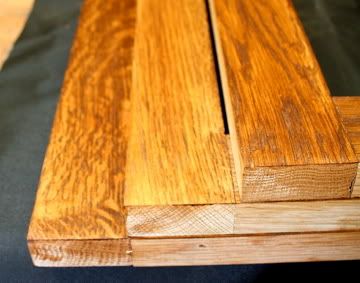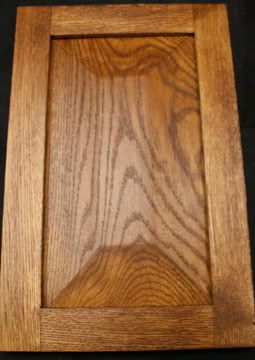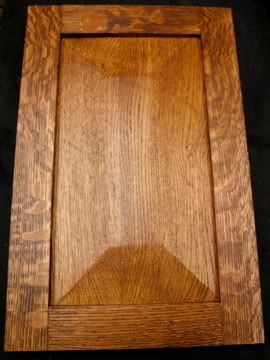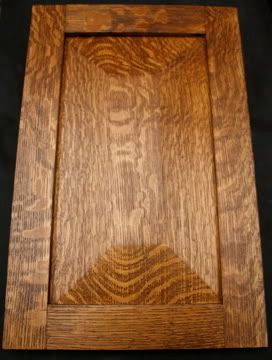Author: Tom Sontag
Paying attention to grain patterns with ring porous hardwoods like oak and ash is an important step in a woodworker's maturation adn a big part pf whether a design succeeds or not. I still have a piece or two I made before I discovered this and frankly, they are hard to look at now. Even though I have since learned to pay attention, I have never seen a systematic review of what different effects were available. So I made three oak frames and three oak panels, stained them to highlight the grain a bit, and interchanged them based upon the grain patterning of how the board was cut from the log. There are nine different combinations. (I was not too exacting with my finishing).
To review, below you see the three frames, with the quartersawn (QS) one at bottom with its annual rings running vertically in the picture and the medullary rays, which radiate from the pith outward, being horizontal. Where the ray surfaces on the face of the board is what yields the showy figure. In the middle is the riftsawn (RS frame, with both rings and rays on diagonals. The plainsawn (PS) frame on top is more like most boards you buy when you buy oak showing the prominent grain patterning of the annual rings on its face.

Here are the three combinations all using the PS frame with PS panel first, RS panel next, and the QS panel third:



In my opinion, none of these are particularly satisfying combinations because the wild uncontrolled grain of the frame is so distracting. And since PS is what you usually get when you buy without paying close attention, this is reason number one to think these things through when you design and when you select boards for a project.
Next, the RS frame with PS, RS and QS panels:



Notice how the frame receeds and lets the panel be the focus? If you are going to use a ring porous wood, I'd almost always default to the RS frame for this reason. Note how quiet and unobtrusive the RS/RS one is? I like the effect but it could be considered almost too quiet; the action of the other two panels can be used to quite good effect, keeping in mind what happens with the other parts of the project that aren't frame and panel construction.
Next, the QS frame with PS, RS and QS panels:



These aren't subtle, huh? Yet i could imagine finding a way to make the last two work. The PS panel is just an outta control visual, like watching a group of leopards go at it with a family of tigers. The RS panel might be a way to calm down a piece with lots of QS material. Most ww'ers seem to like the boisterous use QS with QS; a few craftsman era pieces depend on it.
Anyhow, draw your own conclusions. I've sprinkled mine in here and they are only my opinions. What do you think?
Author: Tom Sontag
Paying attention to grain patterns with ring porous hardwoods like oak and ash is an important step in a woodworker's maturation adn a big part pf whether a design succeeds or not. I still have a piece or two I made before I discovered this and frankly, they are hard to look at now. Even though I have since learned to pay attention, I have never seen a systematic review of what different effects were available. So I made three oak frames and three oak panels, stained them to highlight the grain a bit, and interchanged them based upon the grain patterning of how the board was cut from the log. There are nine different combinations. (I was not too exacting with my finishing).
To review, below you see the three frames, with the quartersawn (QS) one at bottom with its annual rings running vertically in the picture and the medullary rays, which radiate from the pith outward, being horizontal. Where the ray surfaces on the face of the board is what yields the showy figure. In the middle is the riftsawn (RS frame, with both rings and rays on diagonals. The plainsawn (PS) frame on top is more like most boards you buy when you buy oak showing the prominent grain patterning of the annual rings on its face.

Here are the three combinations all using the PS frame with PS panel first, RS panel next, and the QS panel third:



In my opinion, none of these are particularly satisfying combinations because the wild uncontrolled grain of the frame is so distracting. And since PS is what you usually get when you buy without paying close attention, this is reason number one to think these things through when you design and when you select boards for a project.
Next, the RS frame with PS, RS and QS panels:



Notice how the frame receeds and lets the panel be the focus? If you are going to use a ring porous wood, I'd almost always default to the RS frame for this reason. Note how quiet and unobtrusive the RS/RS one is? I like the effect but it could be considered almost too quiet; the action of the other two panels can be used to quite good effect, keeping in mind what happens with the other parts of the project that aren't frame and panel construction.
Next, the QS frame with PS, RS and QS panels:



These aren't subtle, huh? Yet i could imagine finding a way to make the last two work. The PS panel is just an outta control visual, like watching a group of leopards go at it with a family of tigers. The RS panel might be a way to calm down a piece with lots of QS material. Most ww'ers seem to like the boisterous use QS with QS; a few craftsman era pieces depend on it.
Anyhow, draw your own conclusions. I've sprinkled mine in here and they are only my opinions. What do you think?
Author: Tom Sontag
Last edited:

